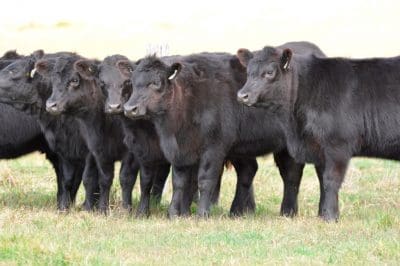There’s been a noticeable widening in premiums paid for Angus feeder cattle in some regions recently, which market observers suggest may be primarily due to growing competition for black cattle to slot into Angus-aligned grainfed brand programs.

A growing perception in industry circles this year has been that 100-day grainfed beef is now becoming a ‘commodity’ item in international beef market circles, that’s increasingly being reflected in pricing.
That’s stimulating brand managers to seek to add additional attributes, such as breed identity, in order to defend margins, in an increasingly hostile global grainfed beef market.
Large volumes of good quality grainfed beef now flowing into export markets in North Asia and elsewhere out of the US is only heightening that ‘commodity’ view about generic 100-day grainfed beef in Australia.
Keen observers of the cattle market for backgrounder and feeder types have highlighted an expanding premium for Angus cattle in recent times. One heavily committed supply chain stakeholder said he could not recollect a larger margin for Angus cattle over everyday flatback (50pc indicus or less) feeders than that being seen at present in the southern Queensland/northern NSW region.
“There appears to be a shortage of Angus cattle in the market, in the context of demand,” he told Beef Central.
“That’s being driven by the fact that a substantial number of very significant grainfed supply chains (he used NH Foods’ enormous Whyalla feedlot as an example) have moved from buying a lot of crossbred feeders, to virtually none.
“Everyone is now doing an Angus program, to try to differentiate themselves in the grainfed market, and consequently a good Angus feeder steer today is selling for 320-330c/kg liveweight, in the northern NSW/southern Queensland region,” he said.
“That Angus premium at present – at least 40c – is as big, if not bigger than it has ever been”
That contrasts with a typical ‘flatback’ heavy feeder steer, quoted in Beef Central’s regular 100-day grainfed trading budget published yesterday at 280c/kg ex Downs.
“That Angus premium at present – at least 40c – is as big, if not bigger than it has ever been” the trade source said.
Historically, Angus premiums in Australia have rarely topped 20c/kg liveweight. Further south in Victoria, premiums tend to be less, purely because of the preponderance of local black cattle relative to other breeds.
Worth pointing out, though, is the fact that some feeder grids (JBS and Bindaree are examples) currently offer Angus premiums worth just 10c/kg liveweight.
“But such offers are made by operators that routinely buy crossbred cattle as well – often in the same consignment,” one contact said. “Those smaller premiums are really directed at mixed runs of cattle, with some blacks and some crossbreds on the same truck, with the 10c/kg premium applying to the straight Angus in the mob,” he said.
“But a lot of supply chains have now moved into the market with Angus-type brand programs, and now the market is short, and competition for feeders is currently very strong in that Angus space.”
Adding to the effect, the fact that straight Angus breeding by and large only happens in the bottom half of the continent only concentrates the current supply challenge.
Perhaps another influence on the current market dynamic, contacts suggest, is the number of Angus breeding cows that have been diverted into F1 Wagyu breeding programs in the past two years – arguably reducing the normal flow of straight Angus feeder cattle coming forward.
“That might be a small factor, but it’s more the fact that the market has wanted to ‘de-commoditise’ itself, by hitching beef brands to breed identity, non-HGP, or some other special brand attribute to get away from the commodity end of the trade,” a supply chain stakeholder said.
Still other impacts on Angus feeder supply this year may be the small but growing numbers of boat cattle to China, taking both slaughter and feeder weights, and the impact of dry conditions on southern Australia.
With a lot of supplementary feeding going on in the south, using cottonseed and other energy-dense feedstuffs, it has perhaps also pushed more of those 350kg southern animals that used to get sold at 400-450kg as a feeder, onto a grain-self feeder until slaughter weight.
“We suspect the dry weather has made that opportunity-feeding or grain assistance happen a fair bit this year, diverting some animal away from the feeder market into a Woolworths, Coles or Scone domestic slaughter program,” one large feeder customer told Beef Central.
Longer days on feed avoids ‘commodity’ beef
NH Foods’ Andrew McDonald made several references to the inherent growing risks in ‘commodity’ grainfed beef in his presentation to the Queensland Rural Press Club recently (see earlier report).
NH Foods clearly identified a move to Wagyu and longer-fed Angus brand programs as part of the company’s strategy, going forward. In this article published earlier on Beef Central, the company outlined its strategy in moving further away from ‘commodity’ 100-day beef, by extending to 150 day and 200-day programs, using verified Black Angus/Angus cattle.
Other large players like Stanbroke and Kilcoy are moving in a similar direction, with heavier emphasis on Angus brand programs, while Rangers Valley and Stockyard have had deeply-entrenched Angus programs for decades.
But is there a risk of going too far? What’s being recognised in some circles already, is the potential for an abundance of ‘Angus’ type programs to in fact turn ‘Angus beef’ into a commodity product itself, despite its inherent meat quality. A victim of its own success, perhaps.
